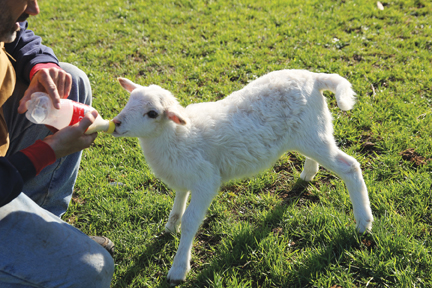Farm & Ranch
Orphan Lambs

By Barry Whitworth, DVM
Sheep producers’ profits depend on many things, but the more lambs that can be marketed, the better the opportunity to make a profit. To increase the number of lambs produced, prolific breeds such as Finnsheep and Romanov are being incorporated into some sheep breeding programs.
One of the outcomes of this breeding program is too many lambs for some ewes to support. This leads to orphan lambs that will have to be bottle fed. Even without using prolific breeds, unfortunate circumstance such as a ewe’s death, mastitis and abandonment result in lambs without mothers. Whatever the cause, producers may have to become the mothers to these lambs.
In ewes that have large numbers of offspring, a decision has to be made as to which lambs need to be removed. In the past, experts recommended removing the stronger lambs and leaving the weaker with the ewe. More recent information suggest that the stronger do better on the ewe and the weaker will gain more weight if artificially reared.
If at all possible, producers should try to foster the lamb on to another ewe. Several “tricks” may be used to fool the ewe to accept the baby. Practices such as rubbing the fetal membranes or fetal fluids on the orphan lamb might fool the ewe.
To read more pick up a copy of the May 2018 NTFR issue. To subscribe call 940-872-5922.
Farm & Ranch
Hazards of Backyard Poultry

By Barry Whitworth, DVM
Having backyard poultry is a popular agriculture enterprise. According to the United States Department of Agriculture, 0.8 percent of all households in the United States have chickens. People keep chickens for a variety of reasons with table eggs being one of the more common reasons.
Unfortunately, some of these poultry producers are not aware of the hazards that come with keeping poultry because many times they carry pathogens but appear healthy.
Chickens are carriers of several zoonotic diseases. These are diseases that can be passed from animals to humans. According to a recent survey in Pennsylvania, a majority of backyard poultry producers were aware of the dangers of avian influenza. However, this study also revealed that far fewer producers were aware of the risk of possible exposure to Salmonella and Campylobacter.
The lack of knowledge about the hazards of raising poultry likely contributes to the continued issues of Salmonella outbreaks associated with backyard poultry. In 2023, the Centers for Disease Control and Prevention reported 1,072 illnesses of Salmonella linked to backyard poultry, and 272 of those patients required hospitalization. Oklahoma reported 43 individuals with the disease.
To read more, pick up a copy of the April issue of NTFR magazine. To subscribe by mail, call 940-872-5922.
Farm & Ranch
Ag Elsewhere: Wyoming

By Tressa Lawrence
Babies are tucked away in every nook and cranny. Many ranchers across Wyoming have baby animals popping up all over this time of year.
Farm & Ranch
Ag Elsewhere: Montana

By Lindsey Monk
Another load of grain in to keep feeding the calves until the green grass can really start popping.
-

 Country Lifestyles1 year ago
Country Lifestyles1 year agoScott & Stacey Schumacher: A Growth Mindset
-

 Equine7 months ago
Equine7 months agoThe Will to Win
-

 Country Lifestyles7 years ago
Country Lifestyles7 years agoStyle Your Profile – What your style cowboy hat says about you and new trends in 2017
-

 Country Lifestyles4 years ago
Country Lifestyles4 years agoAmber Crawford, Breakaway Roper
-

 HOME7 years ago
HOME7 years agoGrazing North Texas – Wilman Lovegrass
-

 Country Lifestyles7 years ago
Country Lifestyles7 years agoDecember 2016 Profile, Rusty Riddle – The Riddle Way
-

 Country Lifestyles8 years ago
Country Lifestyles8 years agoJune 2016 Profile – The man behind the mic: Bob Tallman
-

 Outdoor9 years ago
Outdoor9 years agoButtercup or Primrose?






